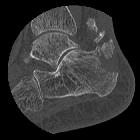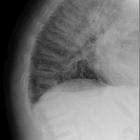calcaneal tuberosity avulsion fracture
Avulsion fractures of the calcaneal tuberosity are rare, accounting for only 3% of all calcaneal fractures.
Pathology
There are three mechanisms of action :
- fall during plantarflexion
- ankle hyperextension
- feet fixed on the ground with sudden muscular contraction
Associations
There is a strong association with diabetes, where they may occur spontaneously and are thought to be due to peripheral neuropathy. They also occur in patients with osteoporosis, renal osteodystrophy and hyperparathyroidism.
Classification
According to Lee et al, this injury can be classified into four types (modification of the original classification system proposed by Beavis et al) :
- type I: simple extra-articular avulsion fracture
- type II: "beak" fracture with oblique fracture line running posteriorly from just behind Bohler's angle
- type III: infrabursal avulsed fracture by superficial fibers from the middle third of the posterior tuberosity
- type IV: "beak" fracture but with a small triangular fragment separated by deep fibers only from the upper border of the tuberosity
Treatment and prognosis
Typically, treatment is with open reduction - internal fixation (ORIF), although minimally displaced fractures may be treated with closed reduction. They have a higher rate of malunion/non-union .
Siehe auch:
und weiter:
 Assoziationen und Differentialdiagnosen zu calcaneal tuberosity avulsion fracture:
Assoziationen und Differentialdiagnosen zu calcaneal tuberosity avulsion fracture:

 ähnliche Suchen
ähnliche Suchen



